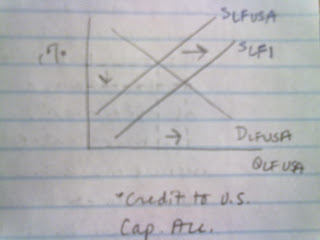- inflows referred to as "CREDITS"
- outflows referred to as "DEBITS"
They are divided into 3 accounts:
- current account
- capital/financial account
- official reserves account
Double Entry Bookkeeping:
*every transaction in balance of payments is recorded twice in accordance w/ standard accounting practice
EX) U.S. manufacturer, John Deere, exports $50 million worth of farm equipment to Ireland.
-a credit of $50 mill. to current account
(-$50 mill. worth of farm equipment or physical assets)
-a debit of $50 mill. to capital/financial account
(+$50 mill. worth of Euros or financial assets)
-notice that the 2 transactions offset (balance) each other. Theoretically, the balance payments should always =0.
Current Account:
1. Balance of Trade of Net Exports
- exports of goods & services --imports of goods & services
- exports create a CREDIT to balance of payments
- imports create a DEBIT to balance of payments
2. Net Foreign Income
- income earned by U.S. owned foreign assets--income paid to foreign held U.S. assets
- EX) Interest payments on U.S. owned Brazilian bonds--interest payments on German owned U.S. treasury bonds
3. Net Transfers (tend to be unilateral→one-sided)
- foreign aid→debit to current account
- EX) Mexican migrant workers send $ to family in Mexico
Capital/Financial Account
*the balance of capital ownership
*includes purchase of both real and financial assets
*direct investment in U.S. is a credit to capital account
EX) Toyota Factory in San Antonio
*direct investment by U.S. firms/individuals in a foreign country are debits to capital account
EX) the Intel Factory in San Jose, Costa Rica
*purchase of foreign financial assets represents a debit to capital account
EX) Warren Buffet (a wealthy man) buys stock in Petrochina
*purchase of domestic financial assets by foreigners represents a credit to capital account
EX) United Arab Emirates sovereign wealth fund purchases a large stake in NASDAQ
What Causes Capital/Financial Flows?
*differences in rates of return on investment
*Ceteris Paribus ("with other things the same" or "all other things being equal"), savings will flow toward higher returns
Relationship b/t Current & Capital Account
*current account and capital account should zero each other out (+/-; surplus/deficit)
EX) The constant net inflow of foreign financial capital to U.S. (capital account surplus) is what enables us to import more than we export (current account deficit)
Official Reserves
*foreign currency holdings of U.S. Federal Reserve System
*when there is a balance of payments surplus, the Fed accumulates foreign currency and debits the balance of payments
*when there is a balance of payments deficit, the Fed depletes its reserves of foreign currency and credits balances of payments
*official reserves zero out the balance (everything)



No comments:
Post a Comment